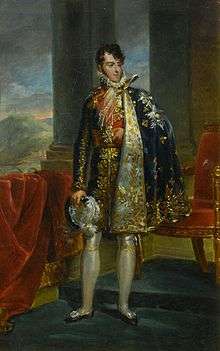Camillo Borghese, 6th Prince of Sulmona
Don Camillo Filippo Ludovico Borghese, Prince of Sulmona and of Rossano, Duke and Prince of Guastalla (19 July 1775 – 9 May 1832) was a member of the Borghese family, best known for being a brother-in-law of Napoleon.


Biography
Camillo Borghese was born in Rome, the son of the pro-Napoleon Marcantonio Borghese, 5th Prince of Sulmona, and brother of Francesco (1776–1839), Prince Aldobrandini. He entered France's service in 1796. He became the second husband of Napoleon's sister Pauline Bonaparte in 1803 (after the death of her first husband, Charles Leclerc).
He was made a prince of the French Empire in 1804, a troop-commander in the Imperial Guard in 1805, and soon afterwards oberst (and later division general). He became the duke of Guastalla in 1806, and commander of 27th and 28th Division of the French Army in 1809.
Initially passionate (he commissioned a nude portrait of her from Canova), the marriage later foundered due to her taking a series of lovers and showing eccentricities such as being carried to her baths by her African slaves and using her ladies-in-waiting for footstools. They led separate lives but did not divorce, and Pauline convinced her brother to give Camillo the governorship of Piedmont in 1808 (with the words "Camillo is an imbecile, no one knows that better than I do. But what does that matter, when we're talking about governing a territory?") and guardianship of Napoleon's prisoner Pope Pius VII.
Napoleon also forced him to sell 344 pieces from the family art collection to the French state, which Camillo made up with new pieces from excavations on his estates. Camillo also took an interest in the family villa at Porta Pinciana, rearranging the display of the collection within it and giving it a new monumental entrance at Piazza del Popolo.
After Napoleon's fall, Camillo's alliance with him proved awkward and he moved to Florence to distance himself from it and her, managing to avoid any of his lands being sequestered by the popes (a usual punishment for pro-Bonaparte tendencies). After 10 years there with a long-term mistress, he was reluctantly convinced by the pope into receiving Pauline back, only 3 months before she died of cancer. He then continued in secret and futile Bonapartist plots until his own death, which occurred at Florence in 1832. He was succeeded in his non-Napoleonic titles by his brother Francesco.
Sources
- Majanlahti, Anthony (2005). The Families Who Made Rome. London: Chatto & Windus. pp. 205 and 180–181. ISBN 0-7011-7687-3.